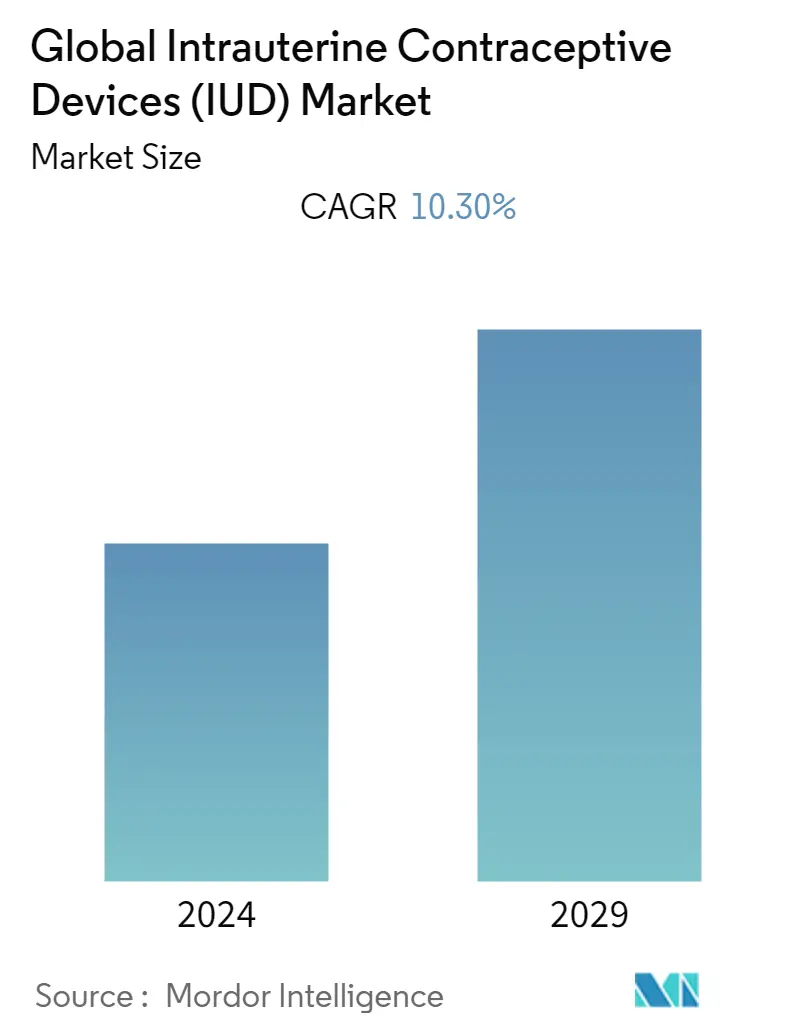
| Study Period | 2019 - 2029 |
| Base Year For Estimation | 2023 |
| Forecast Data Period | 2024 - 2029 |
| Historical Data Period | 2019 - 2022 |
| CAGR | 10.30 % |
| Fastest Growing Market | Asia Pacific |
| Largest Market | North America |
Major Players
*Disclaimer: Major Players sorted in no particular order |
Intrauterine Contraceptive Devices Market Analysis
The Intrauterine Contraceptive Devices (IUD) Market is expected to register a CAGR of 10.3% over the forecast period.
During the COVID-19 pandemic 2020 and increasing cases of COVID-19 worldwide, the health care emphasis has shifted to focus on the apportionment of resources, prevention of viral spread, emergent medical care, and the development of novel treatments and vaccines. Moreover, the unfortunate byproduct of this shift is the de-prioritization of other essential health care services such as access to contraception.
According to a resarch study by Anita Makins et al., published in Gynecology & Obstetrics Journal May 2020, during the COVID-19 pandemic 2020, there was an impending stock-outs of contraceptive methods which are about to ensue. Moreover, United Nations Population Fund (UNFPA) estimates that during the next six months from May 2020, 46 countries that usually receive supplies from them will experience stock-outs of one or more modern methods, including copper intrauterine devices, implants, depot medroxyprogesterone acetate (DMPA) intramuscular (IM) and subcutaneous (SC), oral contraceptive pills (combined and progestin only) and condoms.
In addition, according to the research study by Aisha Dasgupta et al., published in Gates Open Research November 2020, globally, it had been estimated that 77% of women of reproductive age (15-49 years) would have their need for family planning satisfied with modern contraceptive methods in the year 2020. However, taking into account the potential impact of COVID-19 on method-specific use, this could fall to 71%, resulting in around 60 million fewer users of modern contraception worldwide in 2020.
The major factors for the growth of the intrauterine contraceptive devices (IUD) market include the technological innovations leading to effective contraception and fewer side effects, increasing rate of unintended pregnancies, and supportive government initiatives and private firms for the prevention of unwanted abortions and pregnancies.
Unintended pregnancy is an undesired conception. Not using contraception or incorrect use of contraceptive methods can result in unintended pregnancy. The percentage of unintended pregnancies is highest in teens younger than 18 years, followed by women in the age group of 20 to 24 years. These unintentional pregnancies are directly contributing to the raised demand for contraceptive devices.
Moreover, the number of unwanted pregnancies are increasing, and this has become one of serious concerns, globally. For instance, according to World Health Organization (WHO), unintended pregnancies have been an important public health issue. Globally, about 22 million unsafe abortions were estimated to take place each year, which result in the death of an estimated 47,000 women, as per the International Federation of Medical Students' Associations 2018 report.
However, over the past few years, the awareness of contraception has contributed to both the decline in unplanned pregnancies and the growth of the contraception market. Family planning efforts, which include increasing access to intrauterine contraceptive devices, can help reduce unintended pregnancies. The use of IUDs decreased the proportion of births that were unplanned. The usage of IUD is increasing year on year as women find IUD the most convenient, safe, and effective form of contraception.
For instance, according to a research study by Ghzl Ghazi Alenezi et al., published in Middle East Fertility Society Journal April 2021, the study results found that most women in urban Hail community, northern Saudi Arabia, were aware about and have a positive attitude towards family planning. About two-thirds of population were currently using any contraceptive method/s, which is higher than the national estimate for Saudi Arabia. Therefore, the market studied is expected to be driven by the increasing unintended pregnancies, worldwide. However, factor such as risk of causing pelvic inflammatory infection (PID) is likley to impede the market growth in near future.
Intrauterine Contraceptive Devices Industry Segmentation
As per the scope of this report, an intrauterine device (IUD or coil) is a small contraceptive device, often 'T'-shaped, containing either copper or levonorgestrel, which is inserted into the uterus. It is one form of long-acting reversible contraception, which is the most effective type of reversible birth control. The Intrauterine Contraceptive Devices (IUD) Market is segmented by Type (Hormonal Intrauterine Device, Copper Intrauterine Device), End User (Hospitals, Gynecology Clinics and Community Health Care Centers) and Geography (North America, Europe, Asia-Pacific, Middle East and Africa, and South America). The report offers the value (in USD million) for the above segments. The market report also covers the estimated market sizes and trends for 17 different countries across major regions globally.
| Hormonal Intrauterine Device |
| Copper Intrauterine Device |
| Hospitals |
| Gynecology Clinics |
| Community Health Care Centers |
| North America | United States |
| Canada | |
| Mexico | |
| Europe | Germany |
| United Kingdom | |
| France | |
| Italy | |
| Spain | |
| Rest of Europe | |
| Asia-Pacific | China |
| Japan | |
| India | |
| Australia | |
| South Korea | |
| Rest of Asia-Pacific | |
| Middle East and Africa | GCC |
| South Africa | |
| Rest of Middle East and Africa | |
| South America | Brazil |
| Argentina | |
| Rest of South America |
Global Intrauterine Contraceptive Devices (IUD) Market Size Summary
The Intrauterine Contraceptive Devices (IUD) market is poised for significant growth, driven by technological advancements that enhance contraceptive efficacy and reduce side effects. The increasing incidence of unintended pregnancies, particularly among younger women, underscores the rising demand for effective contraceptive solutions. Supportive government policies and initiatives from private sectors further bolster the market, aiming to mitigate unwanted pregnancies and abortions. Despite the challenges posed by the COVID-19 pandemic, which temporarily disrupted access to contraceptive services, the market has shown resilience. The pandemic highlighted the critical need for family planning services, as disruptions led to a potential increase in unintended pregnancies globally. The awareness and acceptance of IUDs as a convenient and effective form of contraception have been on the rise, contributing to market expansion.
The market landscape is characterized by a few dominant players who are actively engaging in mergers, acquisitions, and technological innovations to strengthen their market position. The availability of both copper and hormonal IUDs, with the former offering immediate post-insertion efficacy, caters to diverse consumer preferences. The North American market, in particular, is expected to witness robust growth due to its advanced healthcare infrastructure and heightened awareness of contraceptive options. Ongoing research and development efforts, such as clinical trials for new IUD systems, are anticipated to further drive market growth. The competitive dynamics of the market are shaped by strategic collaborations and regulatory approvals, ensuring a steady supply of innovative contraceptive solutions to meet the evolving needs of women worldwide.
Global Intrauterine Contraceptive Devices (IUD) Market Size - Table of Contents
1. MARKET DYNAMICS
- 1.1 Market Overview
-
1.2 Market Drivers
- 1.2.1 Technological Innovations Leading to Effective Contraception and Less Side Effects
- 1.2.2 Increasing Rate of Unintended Pregnancies
- 1.2.3 Supportive Government Initiatives and Private Firms for the Prevention of Unwanted Abortions and Pregnancies
-
1.3 Market Restraints
- 1.3.1 Risk of Causing Pelvic Inflammatory Infection (PID)
-
1.4 Porter's Five Force Analysis
- 1.4.1 Threat of New Entrants
- 1.4.2 Bargaining Power of Buyers/Consumers
- 1.4.3 Bargaining Power of Suppliers
- 1.4.4 Threat of Substitute Products
- 1.4.5 Intensity of Competitive Rivalry
2. MARKET SEGMENTATION
-
2.1 By Type
- 2.1.1 Hormonal Intrauterine Device
- 2.1.2 Copper Intrauterine Device
-
2.2 By End User
- 2.2.1 Hospitals
- 2.2.2 Gynecology Clinics
- 2.2.3 Community Health Care Centers
-
2.3 Geography
- 2.3.1 North America
- 2.3.1.1 United States
- 2.3.1.2 Canada
- 2.3.1.3 Mexico
- 2.3.2 Europe
- 2.3.2.1 Germany
- 2.3.2.2 United Kingdom
- 2.3.2.3 France
- 2.3.2.4 Italy
- 2.3.2.5 Spain
- 2.3.2.6 Rest of Europe
- 2.3.3 Asia-Pacific
- 2.3.3.1 China
- 2.3.3.2 Japan
- 2.3.3.3 India
- 2.3.3.4 Australia
- 2.3.3.5 South Korea
- 2.3.3.6 Rest of Asia-Pacific
- 2.3.4 Middle East and Africa
- 2.3.4.1 GCC
- 2.3.4.2 South Africa
- 2.3.4.3 Rest of Middle East and Africa
- 2.3.5 South America
- 2.3.5.1 Brazil
- 2.3.5.2 Argentina
- 2.3.5.3 Rest of South America
Intrauterine Contraceptive Devices Market Research FAQs
What is the current Global Intrauterine Contraceptive Devices (IUD) Market size?
The Global Intrauterine Contraceptive Devices (IUD) Market is projected to register a CAGR of 10.3% during the forecast period (2025-2030)
Who are the key players in Global Intrauterine Contraceptive Devices (IUD) Market?
Abbvie Inc (Allergan Plc), Bayer AG, CooperSurgical Inc., DKT International and EUROGINE, S.L are the major companies operating in the Global Intrauterine Contraceptive Devices (IUD) Market.


